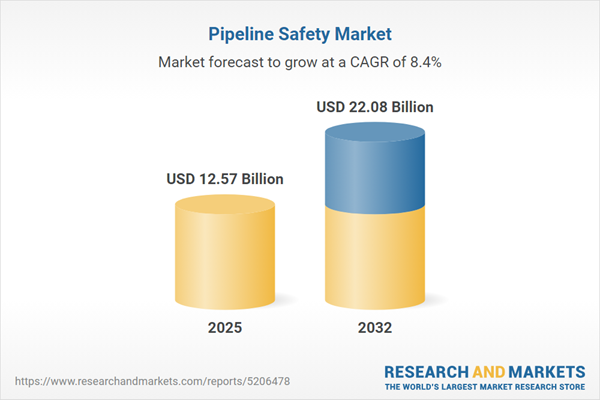Speak directly to the analyst to clarify any post sales queries you may have.
The pipeline safety market is undergoing significant transformation as organizations expand digital capabilities and implement advanced solutions to address operational, regulatory, and risk management needs. Senior decision-makers are seeking robust systems that enable safe, compliant, and efficient pipeline operations worldwide.
Market Snapshot: Pipeline Safety Market Overview
The pipeline safety market is registering robust growth, propelled by tighter compliance mandates and heightened focus on operational resilience across the energy, chemical, and utility sectors. As organizations work to strengthen risk management frameworks, real-time data acquisition, automation, and predictive analytics are increasingly leveraged to enhance incident response and streamline asset performance. Industry stakeholders are responding to global shifts by adopting integrated digital strategies, enabling safer oversight of distributed and complex pipeline assets. Widespread integration of advanced inspection and monitoring solutions, coupled with evolving international standards, continues to drive technology deployment and position leading organizations for regulatory alignment and strong competitive standing in the pipeline safety market.
Scope & Segmentation of the Pipeline Safety Market
- Technology Solutions: Covers cathodic protection systems (impressed current, sacrificial anode), inline inspection tools such as magnetic flux leakage and ultrasonic devices, protective coatings including fusion bonded epoxy and polyethylene, as well as advanced leak detection systems utilizing acoustic sensors, pressure monitors, fiber optics, and IoT platforms. Solutions are further enhanced by integration with satellite and SCADA data to support improved incident response and operational decision-making.
- Service Offerings: Encompasses sensor calibration, regulatory consulting, pigging, ultrasonic inspections, scheduled maintenance, corrosion management, weld repair services, and asset management programs. These offerings are designed to reinforce pipeline integrity, sustain compliance, and reduce the risk of outages across every stage of the asset lifecycle.
- End User Industries: Includes chemical and petrochemical operators, oil and gas value chains, renewable energy producers, and both municipal and industrial water and wastewater systems. Each segment faces unique regulatory and operational risks, influencing the adoption and scope of safety solutions.
- Pipeline Types: Addresses both liquid and gas transmission and distribution systems serving onshore and offshore operations. Tailored safety strategies are essential to manage the distinct logistical, environmental, and regulatory conditions of each pipeline setting.
- Regional Analysis: Reflects varying dynamics across the Americas, Europe, Middle East, Africa, and Asia-Pacific, shaped by local regulations, asset maturity, and investment priorities. These regional attributes inform technology adoption rates and operational strategies for industry participants.
- Competitive Landscape: Features leading technology and solution providers such as Honeywell International, Emerson Electric, Siemens, General Electric, ABB, Schneider Electric, Schlumberger, Baker Hughes, Halliburton, and MSA Safety. These organizations drive innovation in line with evolving technical standards and application requirements, collaborating closely with operators to implement effective pipeline safety programs.
Key Takeaways for Senior Decision-Makers
- Investing in digital monitoring and analytics equips organizations to enhance resilience, manage geographically distributed assets, and support real-time visibility into pipeline conditions.
- Proactively adapting compliance structures fosters agile responses to emerging regulations while enabling transparent governance across international operations.
- Leveraging digital twin technologies and predictive analytics helps optimize maintenance schedules, boost capital efficiency, and extend asset service life.
- Continued emphasis on cybersecurity is vital in protecting critical digital infrastructure, maintaining operational integrity, and meeting stakeholder expectations.
- Forming strategic partnerships with leading technology vendors and domain experts accelerates safety initiative delivery and strengthens execution within complex stakeholder environments.
- Customizing risk management to local requirements ensures sustained regulatory compliance and preserves competitiveness as legislative frameworks shift.
Tariff Impact: Navigating Cost and Supply Chain Shifts
Recent U.S. tariff modifications have prompted organizations to reevaluate sourcing models for pipeline safety technology. Many are transitioning toward domestic and regional suppliers to boost supply chain reliability and reduce dependencies on distant channels. Although initial adjustments may result in short-term cost changes, these efforts lay the groundwork for operational resilience. Companies are modernizing core technologies, deepening supplier engagement, and refining oversight processes to remain compliant and adaptable as regulatory and economic conditions evolve.
Methodology & Data Sources
This report is grounded in targeted industry research, comprehensive review of regulatory trends, and interviews with industry executives. Both qualitative and quantitative perspectives are integrated to deliver actionable recommendations for pipeline risk management and safety enhancement.
Why This Report Matters
- Delivers targeted, decision-ready insights to guide strategic investments and risk mitigation initiatives within the pipeline safety sector.
- Enables benchmarking of available technologies, supplier evaluation, and the optimization of operational approaches for successful project delivery.
- Prepares organizations to anticipate and address evolving industry trends, regulations, and safety requirements across diverse markets.
Conclusion
Focusing on innovation and data-driven strategies supports organizations in navigating evolving pipeline safety demands and regulatory complexities. This report provides a framework for building resilient, future-ready safety programs.
Additional Product Information:
- Purchase of this report includes 1 year online access with quarterly updates.
- This report can be updated on request. Please contact our Customer Experience team using the Ask a Question widget on our website.
Table of Contents
3. Executive Summary
4. Market Overview
7. Cumulative Impact of Artificial Intelligence 2025
Companies Mentioned
The companies profiled in this Pipeline Safety market report include:- Honeywell International Inc.
- Emerson Electric Co.
- Siemens Aktiengesellschaft
- General Electric Company
- ABB Ltd
- Schneider Electric SE
- Schlumberger Limited
- Baker Hughes Company
- Halliburton Company
- MSA Safety Incorporated
Table Information
| Report Attribute | Details |
|---|---|
| No. of Pages | 180 |
| Published | October 2025 |
| Forecast Period | 2025 - 2032 |
| Estimated Market Value ( USD | $ 12.57 Billion |
| Forecasted Market Value ( USD | $ 22.08 Billion |
| Compound Annual Growth Rate | 8.3% |
| Regions Covered | Global |
| No. of Companies Mentioned | 11 |









